tow MITSUBISHI COLT 2008 (in English) User Guide
[x] Cancel search | Manufacturer: MITSUBISHI, Model Year: 2008, Model line: COLT, Model: MITSUBISHI COLT 2008Pages: 450, PDF Size: 14.57 MB
Page 76 of 450
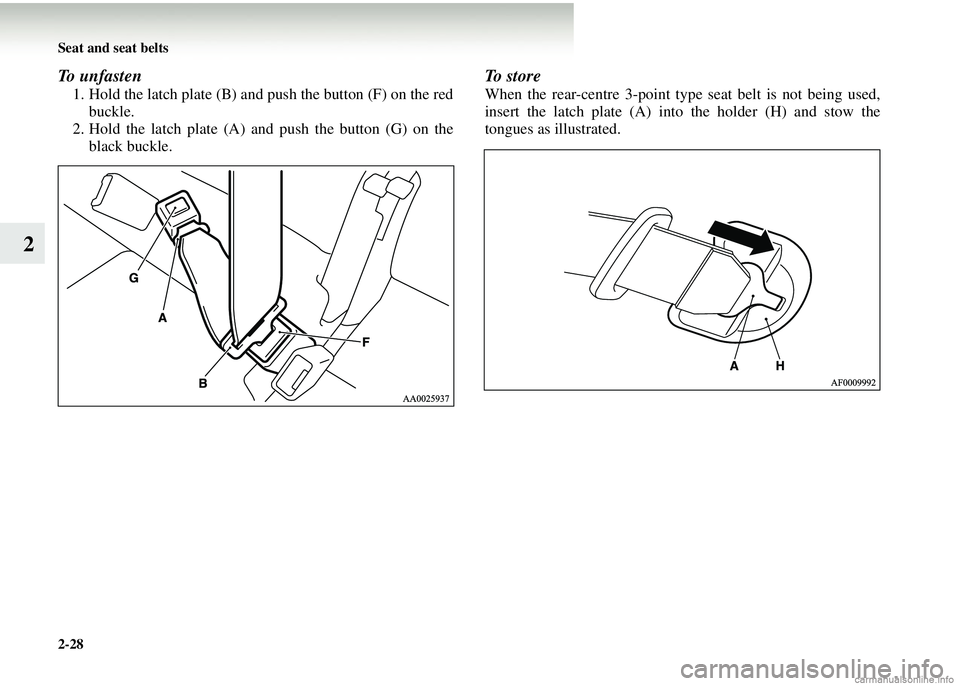
2-28 Seat and seat belts
2
To unfasten
1. Hold the latch plate (B) and push the button (F) on the redbuckle.
2. Hold the latch plate (A) and push the button (G) on the
black buckle.
To s t o r e
When the rear-centre 3-point type seat belt is not being used,
insert the latch plate (A) into the holder (H) and stow the
tongues as illustrated.
Page 131 of 450
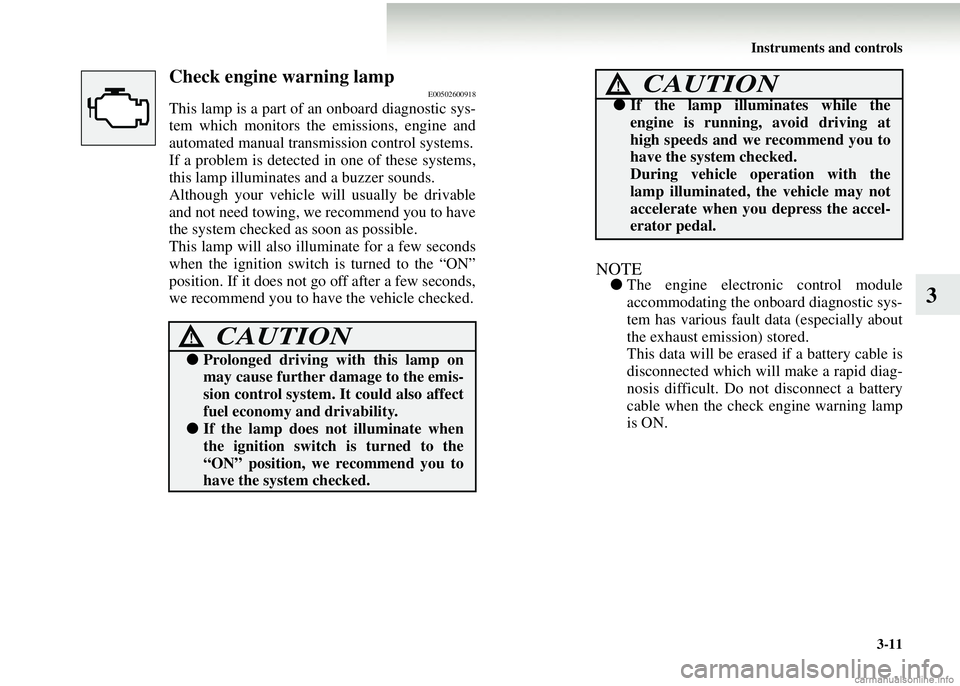
Instruments and controls3-11
3
Check engine warning lampE00502600918
This lamp is a part of an onboard diagnostic sys-
tem which monitors the emissions, engine and
automated manual transmission control systems.
If a problem is detected in one of these systems,
this lamp illuminates and a buzzer sounds.
Although your vehicle will usually be drivable
and not need towing, we recommend you to have
the system checked as soon as possible.
This lamp will also illuminate for a few seconds
when the ignition switch is turned to the “ON”
position. If it does not go off after a few seconds,
we recommend you to have the vehicle checked.
NOTE● The engine electr onic control module
accommodating the onboard diagnostic sys-
tem has various fault data (especially about
the exhaust emission) stored.
This data will be erased if a battery cable is
disconnected which will make a rapid diag-
nosis difficult. Do not disconnect a battery
cable when the check engine warning lamp
is ON.
CAUTION!
● Prolonged driving with this lamp on
may cause further damage to the emis-
sion control system. It could also affect
fuel economy and drivability.
● If the lamp does not illuminate when
the ignition switch is turned to the
“ON” position, we recommend you to
have the system checked.
●If the lamp illuminates while the
engine is running, avoid driving at
high speeds and we recommend you to
have the system checked.
During vehicle operation with the
lamp illuminated, the vehicle may not
accelerate when you depress the accel-
erator pedal.
CAUTION!
Page 163 of 450
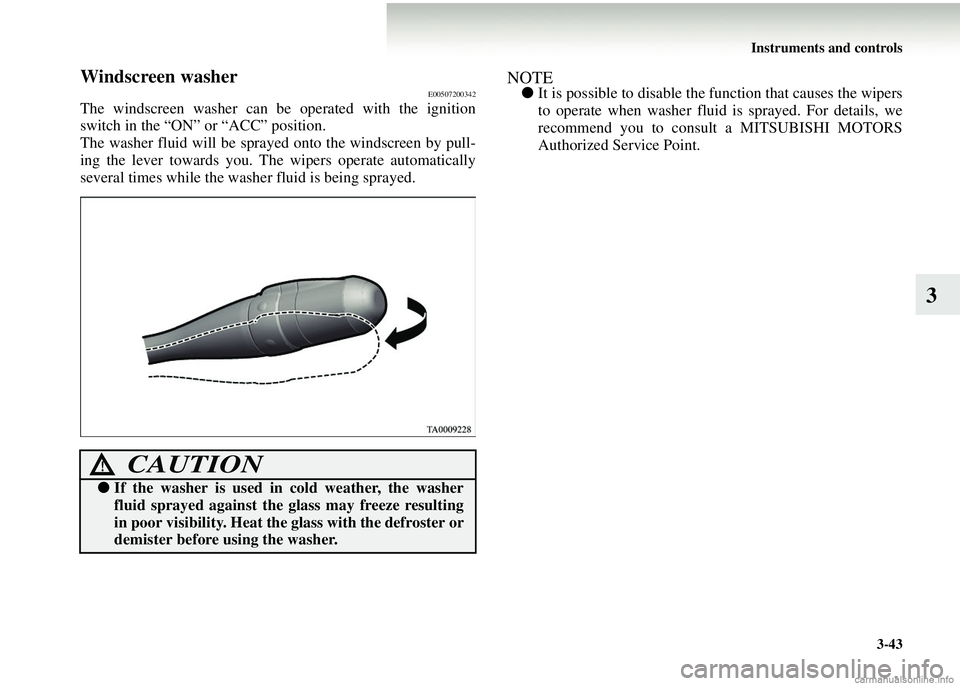
Instruments and controls3-43
3
Windscreen washerE00507200342
The windscreen washer can be operated with the ignition
switch in the “ON” or “ACC” position.
The washer fluid will be sprayed onto the windscreen by pull-
ing the lever towards you. Th e wipers operate automatically
several times while the washer fluid is being sprayed.
NOTE● It is possible to disable the function that causes the wipers
to operate when washer fluid is sprayed. For details, we
recommend you to consult a MITSUBISHI MOTORS
Authorized Service Point.
CAUTION!
● If the washer is used in cold weather, the washer
fluid sprayed against the glass may freeze resulting
in poor visibility. Heat the glass with the defroster or
demister before using the washer.
Page 167 of 450
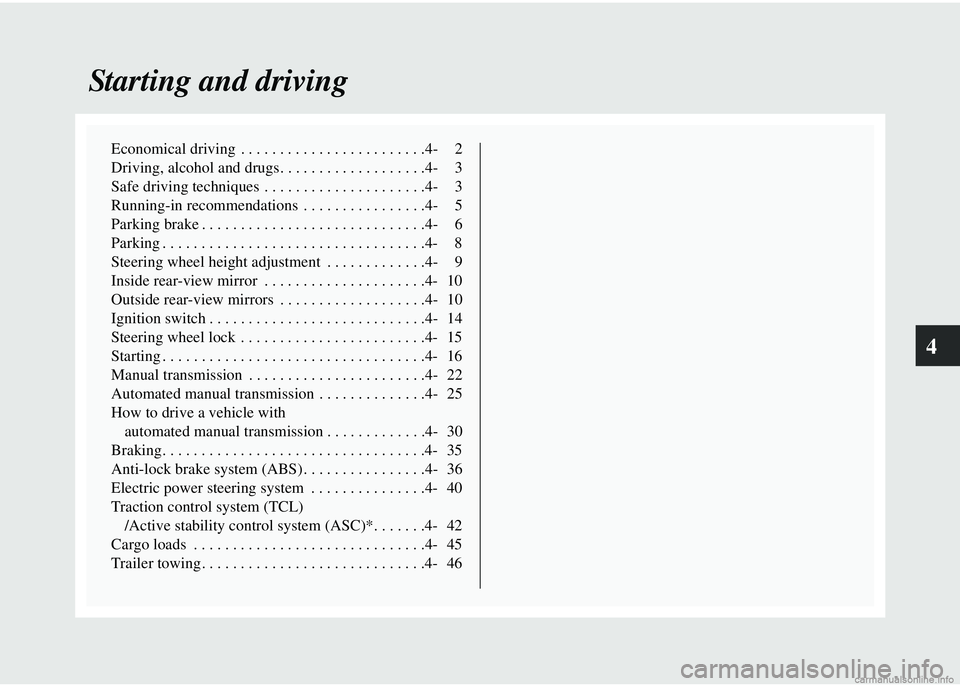
4
Starting and driving
Economical driving . . . . . . . . . . . . . . . . . . . . . . . .4- 2
Driving, alcohol and drugs. . . . . . . . . . . . . . . . . . .4- 3
Safe driving techniques . . . . . . . . . . . . . . . . . . . . .4- 3
Running-in recommendations . . . . . . . . . . . . . . . .4- 5
Parking brake . . . . . . . . . . . . . . . . . . . . . . . . . . . . .4- 6
Parking . . . . . . . . . . . . . . . . . . . . . . . . . . . . . . . . . .4- 8
Steering wheel height adjustment . . . . . . . . . . . . .4- 9
Inside rear-view mirror . . . . . . . . . . . . . . . . . . . . .4- 10
Outside rear-view mirrors . . . . . . . . . . . . . . . . . . .4- 10
Ignition switch . . . . . . . . . . . . . . . . . . . . . . . . . . . .4- 14
Steering wheel lock . . . . . . . . . . . . . . . . . . . . . . . .4- 15
Starting . . . . . . . . . . . . . . . . . . . . . . . . . . . . . . . . . .4- 16
Manual transmission . . . . . . . . . . . . . . . . . . . . . . .4- 22
Automated manual transmission . . . . . . . . . . . . . .4- 25
How to drive a vehicle with automated manual transmission . . . . . . . . . . . . .4- 30
Braking. . . . . . . . . . . . . . . . . . . . . . . . . . . . . . . . . .4- 35
Anti-lock brake system (ABS) . . . . . . . . . . . . . . . .4- 36
Electric power steering system . . . . . . . . . . . . . . .4- 40
Traction control system (TCL) /Active stability control syst em (ASC)*. . . . . . .4- 42
Cargo loads . . . . . . . . . . . . . . . . . . . . . . . . . . . . . .4- 45
Trailer towing. . . . . . . . . . . . . . . . . . . . . . . . . . . . .4- 46
Page 171 of 450
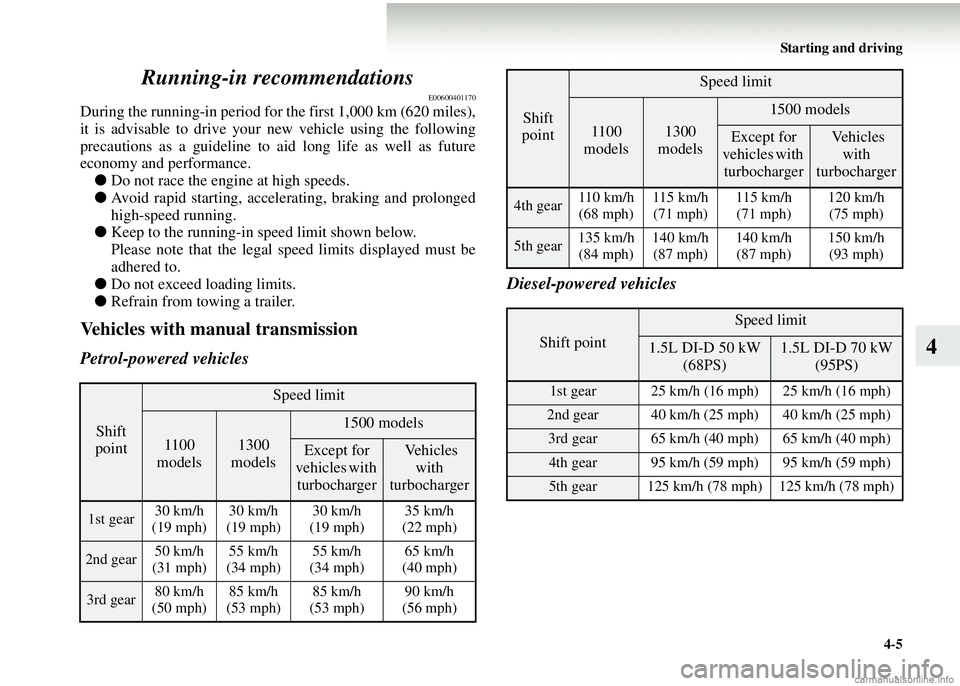
Starting and driving4-5
4
Running-in recommendations
E00600401170
During the running-in period for the first 1,000 km (620 miles),
it is advisable to drive your new vehicle using the following
precautions as a guideline to aid
long life as well as future
economy and performance. ● Do not race the engine at high speeds.
● Avoid rapid starting, accelerating, braking and prolonged
high-speed running.
● Keep to the running-in speed limit shown below.
Please note that the legal speed limits displayed must be
adhered to.
● Do not exceed loading limits.
● Refrain from towing a trailer.
Vehicles with manual transmission
Petrol-powered vehicles Diesel-powered vehicles
Shift
point
Speed limit
1100
models1300
models
1500 models
Except for
vehicles with turbocharger Vehicles
with
turbocharger
1st gear 30 km/h
(19 mph) 30 km/h
(19 mph) 30 km/h
(19 mph) 35 km/h
(22 mph)
2nd gear 50 km/h
(31 mph) 55 km/h
(34 mph) 55 km/h
(34 mph) 65 km/h
(40 mph)
3rd gear 80 km/h
(50 mph) 85 km/h
(53 mph) 85 km/h
(53 mph) 90 km/h
(56 mph)
4th gear 110 km/h
(68 mph) 115 km/h
(71 mph) 115 km/h
(71 mph) 120 km/h
(75 mph)
5th gear 135 km/h
(84 mph) 140 km/h
(87 mph) 140 km/h
(87 mph) 150 km/h
(93 mph)
Shift point
Speed limit
1.5L DI-D 50 kW (68PS)1.5L DI-D 70 kW (95PS)
1st gear 25 km/h (16 mph) 25 km/h (16 mph)
2nd gear 40 km/h (25 mph) 40 km/h (25 mph)
3rd gear 65 km/h (40 mph) 65 km/h (40 mph)
4th gear 95 km/h (59 mph) 95 km/h (59 mph)
5th gear 125 km/h (78 mph) 125 km/h (78 mph)
Shift
point
Speed limit
1100
models1300
models
1500 models
Except for
vehicles with turbocharger Vehicles
with
turbocharger
Page 173 of 450

Starting and driving4-7
4
To r e l e a s e
When parking on a hill, apply the parking brake and turn the
front wheels towards the kerb on a downhill grade, away from
the kerb on an uphill grade.
1- Pull the lever up slightly.
2- Push the button at the end of the hand grip.
3- Push the lever downward.
CAUTION!
● Before driving, be sure that the parking brake is
fully released and brake warning lamp is off.
If a vehicle is driven wi thout releasing the parking
brake, the brake will be overheated, resulting in
ineffective brak ing and possible brake failure.
●When you intend to apply the parking brake, firmly
press the brake pedal to bring the vehicle to a com-
plete stop before pullin g the parking brake lever.
Pulling the parking brake lever with the vehicle
moving could make the rear wheels lock up, thereby
making the vehicle unstable.
● If the brake warning lamp does not extinguish when
the parking brake is fully released, the brake system
may be abnormal. For details, refer to “Brake warn-
ing lamp” on page 3-9.
CAUTION!
Page 174 of 450
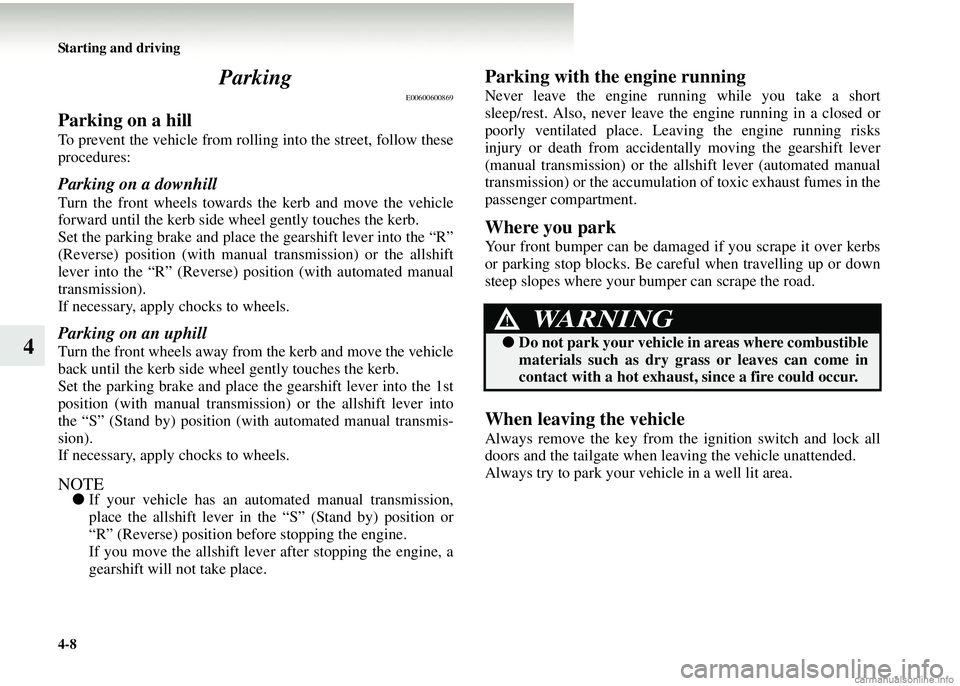
4-8 Starting and driving
4Parking
E00600600869
Parking on a hill
To prevent the vehicle from rolling into the street, follow these
procedures:
Parking on a downhill
Turn the front wheels towards
the kerb and move the vehicle
forward until the kerb side wheel gently touches the kerb.
Set the parking brake and place the gearshift lever into the “R”
(Reverse) position (with manual transmission) or the allshift
lever into the “R” (Reverse) position (with automated manual
transmission).
If necessary, apply chocks to wheels.
Parking on an uphill
Turn the front wheels away from the kerb and move the vehicle
back until the kerb side wheel gently touches the kerb.
Set the parking brake and place th e gearshift lever into the 1st
position (with manual transmission) or the allshift lever into
the “S” (Stand by) position (with automated manual transmis-
sion).
If necessary, apply chocks to wheels.
NOTE● If your vehicle has an automated manual transmission,
place the allshift lever in the “S” (Stand by) position or
“R” (Reverse) position before stopping the engine.
If you move the allshift lever after stopping the engine, a
gearshift will not take place.
Parking with the engine running
Never leave the engine running while you take a short
sleep/rest. Also, never leave the engine running in a closed or
poorly ventilated place. Leaving the engine running risks
injury or death from accidental ly moving the gearshift lever
(manual transmission) or the allshift lever (automated manual
transmission) or the accumulation of toxic exhaust fumes in the
passenger compartment.
Where you park
Your front bumper can be damaged if you scrape it over kerbs
or parking stop blocks. Be careful when travelling up or down
steep slopes where your bumper can scrape the road.
When leaving the vehicle
Always remove the key from the ignition switch and lock all
doors and the tailgate when leaving the vehicle unattended.
Always try to park your vehicle in a well lit area.
WARNING!
● Do not park your vehicle in areas where combustible
materials such as dry grass or leaves can come in
contact with a hot exhaust, since a fire could occur.
Page 179 of 450
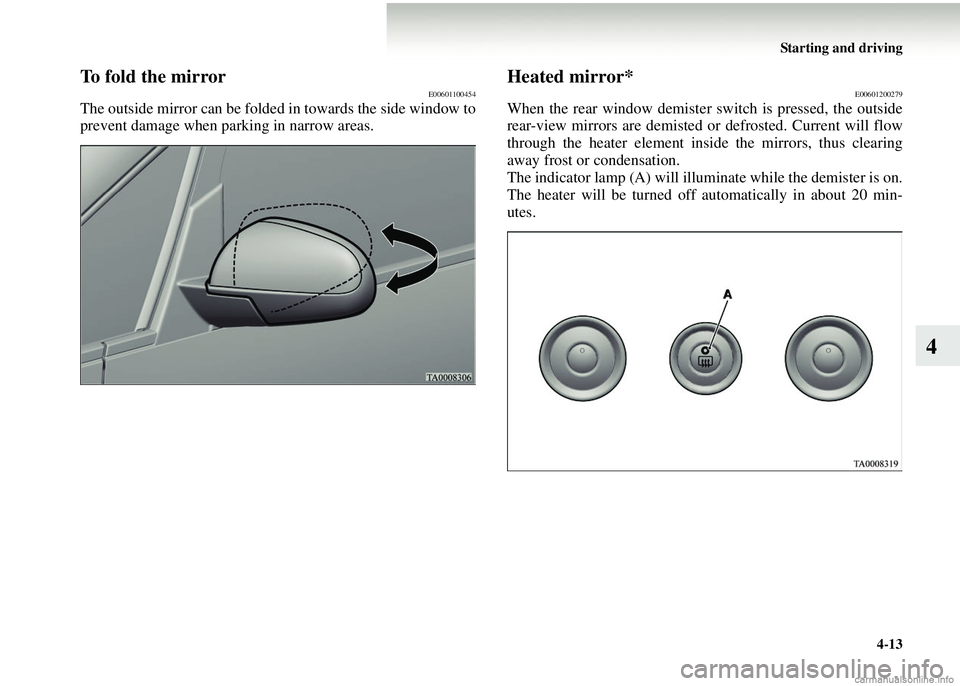
Starting and driving4-13
4
To fold the mirrorE00601100454
The outside mirror can be folded in towards the side window to
prevent damage when parking in narrow areas.
Heated mirror*E00601200279
When the rear window demister switch is pressed, the outside
rear-view mirrors are demisted or defrosted. Current will flow
through the heater element insi de the mirrors, thus clearing
away frost or condensation.
The indicator lamp (A) will illuminate while the demister is on.
The heater will be turned off automatically in about 20 min-
utes.
Page 211 of 450
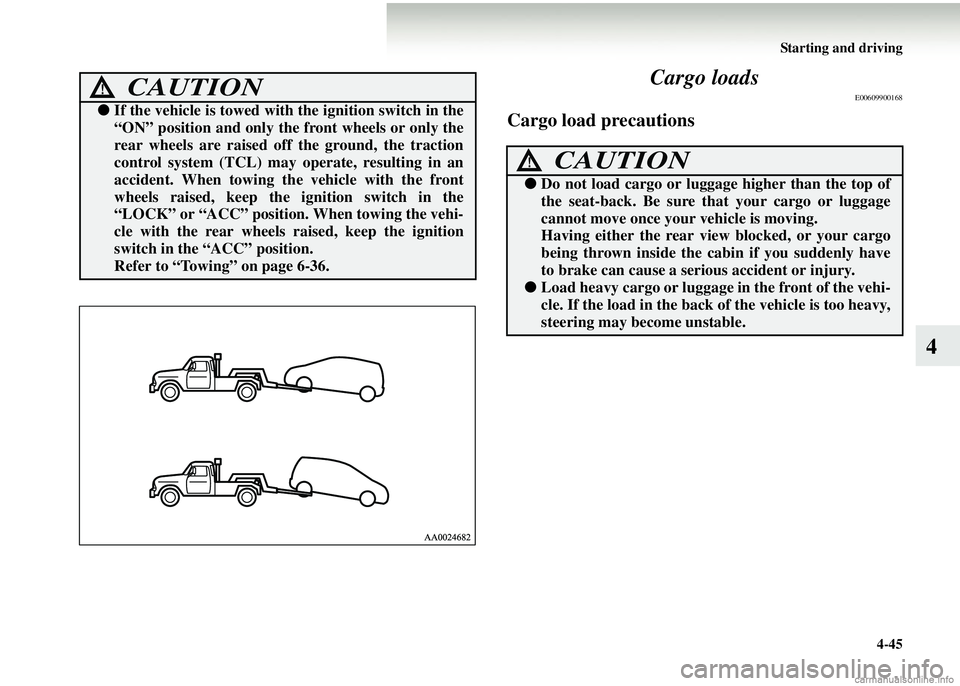
Starting and driving4-45
4
Cargo loads
E00609900168
Cargo load precautions
CAUTION!
●
If the vehicle is towed with the ignition switch in the
“ON” position and only the front wheels or only the
rear wheels are raised off the ground, the traction
control system (TCL) may operate, resulting in an
accident. When towing th e vehicle with the front
wheels raised, keep the ig nition switch in the
“LOCK” or “ACC” position. When towing the vehi-
cle with the rear wheels raised, keep the ignition
switch in the “ACC” position.
Refer to “Towing” on page 6-36.
CAUTION!
● Do not load cargo or luggage higher than the top of
the seat-back. Be sure that your cargo or luggage
cannot move once your vehicle is moving.
Having either the rear view blocked, or your cargo
being thrown inside the cabin if you suddenly have
to brake can cause a serious accident or injury.
●Load heavy cargo or luggage in the front of the vehi-
cle. If the load in the back of the vehicle is too heavy,
steering may become unstable.
Page 212 of 450
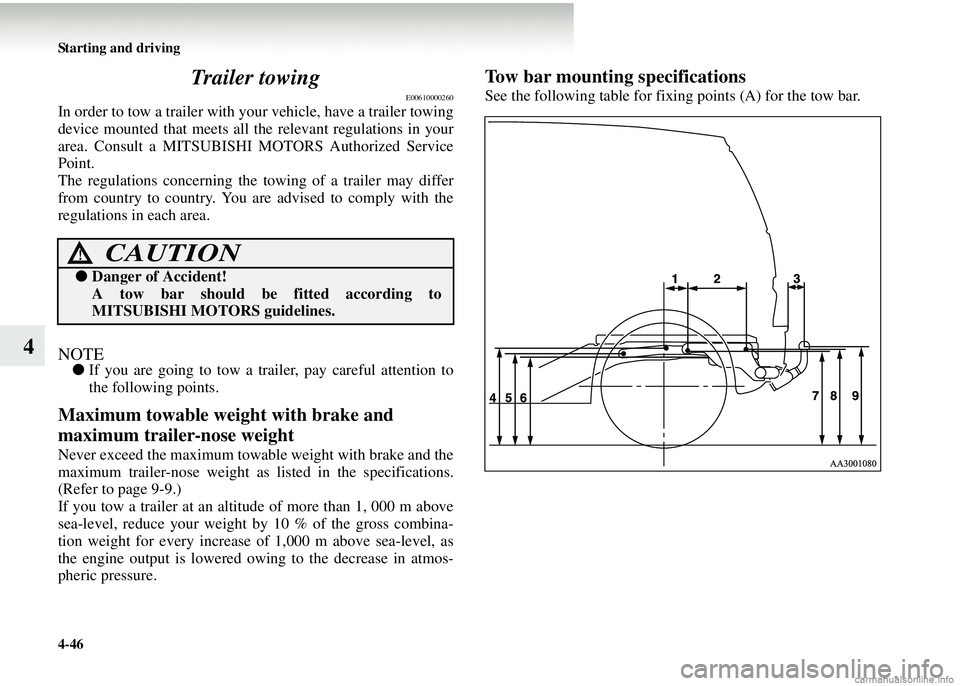
4-46 Starting and driving
4Trailer towing
E00610000260
In order to tow a trailer with you
r vehicle, have a trailer towing
device mounted that meets all th e relevant regulations in your
area. Consult a MITSUBISHI MOTORS Authorized Service
Point.
The regulations concerning the towing of a trailer may differ
from country to country. You are advised to comply with the
regulations in each area.
NOTE● If you are going to tow a trailer, pay careful attention to
the following points.
Maximum towable weight with brake and
maximum trailer-nose weight
Never exceed the maximum towabl e weight with brake and the
maximum trailer-nose weight as listed in the specifications.
(Refer to page 9-9.)
If you tow a trailer at an altitude of more than 1, 000 m above
sea-level, reduce your weight by 10 % of the gross combina-
tion weight for every increase of 1,000 m above sea-level, as
the engine output is lowered owing to the decrease in atmos-
pheric pressure.
Tow bar mounting specifications
See the following table for fixing points (A) for the tow bar.
CAUTION!
● Danger of Accident!
A tow bar should be fitted according to
MITSUBISHI MOTORS guidelines.